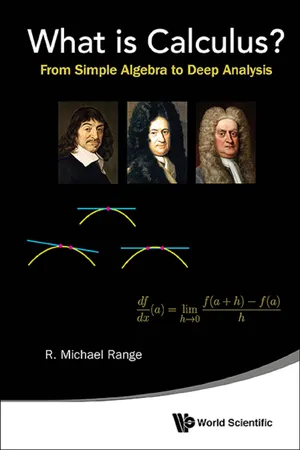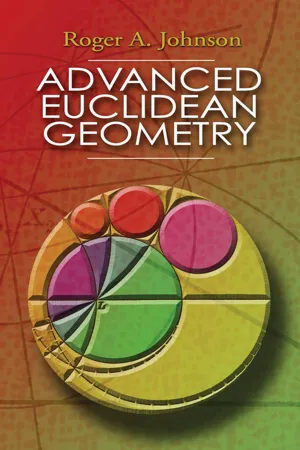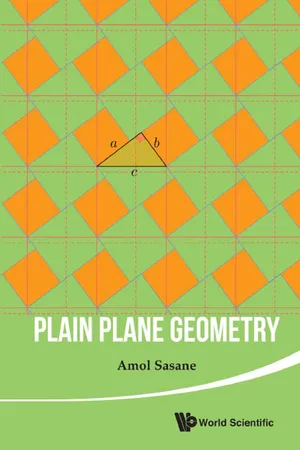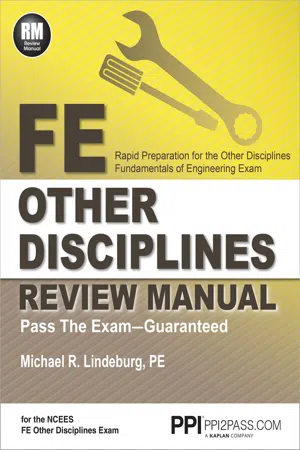Mathematics
Tangent of a Circle
The tangent of a circle is a line that intersects the circle at exactly one point, known as the point of tangency. This line is perpendicular to the radius of the circle at the point of tangency. In trigonometry, the tangent function represents the ratio of the length of the opposite side to the length of the adjacent side in a right-angled triangle.
Written by Perlego with AI-assistance
Related key terms
7 Key excerpts on "Tangent of a Circle"
- eBook - ePub
What is Calculus?
From Simple Algebra to Deep Analysis
- R Michael Range(Author)
- 2015(Publication Date)
- WSPC(Publisher)
In general, the line that is perpendicular to a tangent at a point P on a curve is called the normal to the curve at P. Circles are special, since all normals go through the center and consequently are easy to draw for any point P on the circle. However, when one considers more general curves, there is no obvious way to construct normals and/or tangents. Finding either one immediately determines the other. 1 The main problem then is to turn the intuitive but vague ancient idea of “tangent” recalled above into a precise definition that can be used to identify tangents and determine their slopes for arbitrary curves. Intuitively, we recognize that (in a small neighborhood) a tangent intersects the curve under consideration only at one point P —the point of tangency —while most small perturbations (i.e., changes) of the tangent will intersect the curve at two distinct points close to P. (See Figure 2.) Fig. 1 Circle with tangent at point P. Fig. 2 Perturbation of a tangent reveals two points of intersection. So the tangent intersects the curve at the single point P, which however covers two (or more) overlapping points that separate when the tangent is rotated just so slightly. The point P of tangency really accounts for two points of intersection that just happen to coincide in the special case of a tangent. We call such a point a “double point”, or a point of “multiplicity two”. Note that for any other line through P that “cuts” the curve—and hence does not fit our intuitive idea of a tangent— the point of intersection really gets counted only once. In Figure 3, the dashed lines are perturbations of such a line through P ; they still intersect the curve only at one point (at least in a neighborhood of P). Fig. 3 Perturbations of a line that is not a tangent. In certain situations the point of tangency may hide more than two points. In Figure 4 the horizontal line is tangent to the curve at P - eBook - ePub
- Roger A. Johnson(Author)
- 2013(Publication Date)
- Dover Publications(Publisher)
CHAPTER VI TANGENT CIRCLES150. In this chapter* we apply the general principles which we have been developing, to the specific problems of systems of tangent circles. To two circles there are infinitely many tangent circles, and the first part of the chapter is devoted to the study of these systems of circles, and to a number of interesting configurations associated with them. We then consider various aspects of the problem of Apollonius, to construct a circle tangent to three given circles. This famous problem has a finite number of solutions, not exceeding eight. The next problem is that of four circles; if four given circles are tangent to a circle, they must satisfy a special condition. The nature of this condition was discovered by J. Casey, and is worked out carefully. The chapter closes with a brief consideration of circles intersecting at constant angles, and at equal angles.151. Definitions. Two circles are said to be externally tangent, when they lie on opposite sides of the tangent at their point of contact; internally tangent, when on the same side.If a circle is tangent to two others, we distinguish between the case that it has like contacts of either type, and the case that it is internally tangent to one and externally tangent to the other.152. Theorem. Two circles are externally tangent if the distance between their centers equals the sum of their radii; internally tangent, if it equals the difference.153. Theorem. If two tangent circles are subjected to an inversion, the type of tangency is unchanged, except when the center of inversion is inside one circle but outside the other.154. Theorem. - eBook - ePub
- Amol Sasane(Author)
- 2015(Publication Date)
- WSPC(Publisher)
BC . But these two perpendicular bisectors are distinct parallel lines, and cannot have a point in common.In the last case when the line touches the circle at exactly one point, we say that the line is tangent to the circle, and call it a tangent line , while the common point between the tangent line and the circle is referred to as the point of tangency .Theorem 5.19 . If a line is tangent to a circle, then the line joining the center of the circle to the point of tangency is perpendicular to the tangent line .Proof . Let ℓ be the tangent line. Let O be the center of the circle, and P be the point of tangency. If Q /=P is any point on ℓ , then Q must lie outside the circle. (Q can’t be on the circle, since ℓ , being a tangent, ought to meet the circle at one point alone. Also Q can’t be inside the circle either, because then PQ extended would meet the circle at another point, and so again this contradicts the fact that ℓ is a tangent line!) But then OQ > radius of the circle = OP . As this holds for all Q /=P on ℓ , it follows that P is the point on ℓ which is closest to O . But by Theorem 3.10 , we then conclude that OP ⊥ ℓ .Theorem 5.20 . If T is a point on the circle C (O, r ), P is a point outside the circle C (O, r ), and ∠OTP = 90°, then PT is a tangent to C (O, r ) with point of tangency T .Proof . As T is a point on the circle, the line ℓ through P, T does meet the circle. Suppose that ℓ is not tangential to C (O, r ). Then ℓ meets C (O, r ) at another point T ′ ≠ T . The perpendicular bisector of TT ′ contains the center O of the circle. From the two pictures above, we see that ∠OTP - eBook - ePub
Military schools and courses of instruction in the science and art of war,
in France, Prussia, Austria, Russia, Sweden, Switzerland, Sardinia, England, and the United States. Drawn from recent official reports and documents. Revised Edition
- (Author)
- 2013(Publication Date)
- Perlego(Publisher)
6 —The point in which the tangent meets one of the axes prolonged is independent of the length of the other axis.—Construction of the tangent at any point of the ellipse by means of this property.The radii vectores, drawn from the foci to any point of the ellipse, make equal angles with the tangent at that point or the same side of it.—The normal bisects the angle made by the radii vectores with each other.—This property may serve to draw a tangent to the ellipse through a point on the curve, or through a point exterior to it.The diameters of the ellipse are right lines passing through the centre of the curve.—The chords which a diameter bisects are parallel to the tangent drawn through the extremity of that diameter.—Supplementary chords. By means of them a tangent to the ellipse can be drawn through a given point on that curve or parallel to a given right line. - Alan Sultan, Alice F. Artzt(Authors)
- 2017(Publication Date)
- Routledge(Publisher)
Look at Figure 5.22 which shows an acute triangle and its circumscribed circle. Figure 5.22 If the triangle is acute, then the center of the circle is always inside the triangle and we can draw altitude DF to isosceles triangle ADB and it will bisect angle ADB as well as the base. Now, in triangle A D F sin α = A F r = A F d 2 where d is the diameter of the circle. Inverting the d 2 and multiplying, we get that sin α = 2 A F d = A B d. Rewriting this as A B sin α = d (5.43) and realizing that sin α = sin C and AB is side c in triangle ABC, equation (5.43) becomes c sin C = d. (5.44) That is, the ratio of c to sin C is the diameter. Since, there was nothing special about angle C, a similar proof shows that a sin A and b sin B are both d. So, a sin A = b sin B = c sin C = d and this gives us not only the law of sines, but tells us exactly what the common ratios are, the diameter of the circumscribed circle! There is yet another corollary of this which may seem obscure now, but will be put to good use later in section 5.6.2. Corollary 5.16 In a circle with diameter 1, if we have an inscribed angle of measure α, intercepting arc AB, then the length of the chord joining the points A and B has length sin α. That is, sin α = AB. Proof. We simply let d = 1 in equation (5.43) and the result follows immediately by cross multiplying. 5.6.2 Secants and Tangents In this section we deal with some of the main theorems concerning tangents and secants. Recall that a secant line to a circle is a line drawn from an external point which cuts through the circle and stops at the other side. We have drawn a picture of a secant in Figure 5.23. A P ¯ is the secant. Figure 5.23 Theorem 5.17 If two secants, with lengths s 1 and s 2 are drawn to a circle from an external point, and the parts of them which are external to the circle are e 1 and e 2, then s 1 e 1 = s 2 e 2. Proof- Michael R. Lindeburg(Author)
- 2014(Publication Date)
- PPI, a Kaplan Company(Publisher)
1 ).ExampleA circle with a radius of 5 is centered at the origin.What is the standard form of the equation of the line tangent to this circle at the point (3, 4)?(A)(B)(C)(D)SolutionThe slope of the radius line from point to point is 4/3. Since the radius and tangent line are perpendicular, the slope of the tangent line is −3/4.The point-slope form of a straight line with slope and containing pointRearranging this into standard form givesisThe answer is (D).Equation 1.6: Angle Between Two Lines1.6Description Two intersecting lines in two-dimensional space are shown in Fig. 1.2.Figure 1.2Two Lines Intersecting in Two-Dimensional SpaceThe slopes of the two lines are m 1 and m 2 . The acute angle, α , between the lines is given by Eq. 1.6.1ExampleThe angle between the line y = –7x + 12 and the line y = 3x is most nearly(A) 22°(B) 27°(C) 33°(D) 37°Solution Use Eq. 1.6.The answer is (B).2. Polynomial FunctionsEquation 1.7 and Eq. 1.8: Quadratic Equations1.71.8DescriptionA quadratic equation is a second-degree polynomial equation with a single variable. A quadratic equation can be written in the form of Eq. 1.7, where x is the variable and a , b , and c are constants. (If a is zero, the equation is linear.)The roots , x 1 and x 2 , of a quadratic equation are the two values of x that satisfy the equation (i.e., make it true). These values can be found from the quadratic formula , Eq. 1.8.The quantity under the radical in Eq. 1.8 is called the discriminant . By inspecting the discriminant, the types of roots of the equation can be determined.-
If b 2 − 4ac > 0, the roots are real and unequal.
-
If b 2 − 4ac = 0, the roots are real and equal. This is known as a double root.
- eBook - ePub
- Michael R. Lindeburg(Author)
- 2014(Publication Date)
- PPI, a Kaplan Company(Publisher)
1 ).ExampleA circle with a radius of 5 is centered at the origin.What is the standard form of the equation of the line tangent to this circle at the point (3, 4)?(A)(B)(C)(D)SolutionThe slope of the radius line from point to point is 4/3. Since the radius and tangent line are perpendicular, the slope of the tangent line is −3/4.The point-slope form of a straight line with slope and containing pointRearranging this into standard form givesisThe answer is (D).Equation 1.6: Angle Between Two Lines2.6Description Two intersecting lines in two-dimensional space are shown in Fig. 1.2.Figure 2.2Two Lines Intersecting in Two-Dimensional SpaceThe slopes of the two lines are m 1 and m 2 . The acute angle, α , between the lines is given by Eq. 1.6.1ExampleThe angle between the line y = –7x + 12 and the line y = 3x is most nearly(A) 22°(B) 27°(C) 33°(D) 37°Solution Use Eq. 1.6.The answer is (B).2. Polynomial FunctionsEquation 1.7 and Eq. 1.8: Quadratic Equations2.72.8DescriptionA quadratic equation is a second-degree polynomial equation with a single variable. A quadratic equation can be written in the form of Eq. 1.7, where x is the variable and a , b , and c are constants. (If a is zero, the equation is linear.)The roots , x 1 and x 2 , of a quadratic equation are the two values of x that satisfy the equation (i.e., make it true). These values can be found from the quadratic formula , Eq. 1.8.The quantity under the radical in Eq. 1.8 is called the discriminant . By inspecting the discriminant, the types of roots of the equation can be determined.-
If b 2 − 4ac > 0, the roots are real and unequal.
-
If b 2 − 4ac = 0, the roots are real and equal. This is known as a double root.
Index pages curate the most relevant extracts from our library of academic textbooks. They’ve been created using an in-house natural language model (NLM), each adding context and meaning to key research topics.






